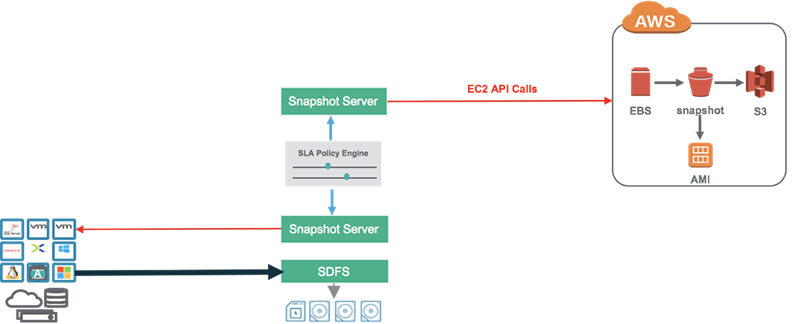For most IT professionals, data protection is a difficult and thankless task. Adding to the pain, data protection tools can be even more complex and brittle than manual processes. Take, for example, the protection of virtual machines/instances in the public cloud. The primitives help protect your data, but automating the process often requires cobbling together various scripts and services that have to be constantly maintained.
Solving these pain points was a major part of the recent Rubrik Alta 4.2 release. Based on customer demand, we’ve made simplifying the protection of cloud workloads a key benefit of our platform, beginning with Amazon Web Services (AWS) EC2 instances.

In a previous post, I provided an overview of the various AWS primitives, such as EBS snapshots and Amazon Machine Images, that are involved with EC2 instance protection. This post will go under the hood of how Rubrik uses these primitives to automate and simplify protection.
What Challenges Are We Solving For?
We designed Alta 4.2 to address the top data management challenges we heard from customers and prospects who are running workloads in AWS. This includes those who are new to the public cloud and those who run primarily in the cloud. Here are the top challenges and how Rubrik addresses them:
- Lack of automated lifecycle management tools: Rubrik integrates AWS native protection with the concept of SLA Domains. Instead of having to build scripts with cron jobs to schedule periodic snapshots, customers just declare how often to take and how long to retain their snapshots and machine images.
- Time-consuming recovery from failure or data corruption: Recovering a volume or a file from EBS snapshots is a multi-step process that can be time consuming and error prone. Rubrik applies a declarative approach so that a user just expresses which volume or file needs to be recovered, and we’ll take care of the rest.
- Another infrastructure brings another management tool: If possible, customers prefer not managing multiple tools. Because of Rubrik Alta’s modular design, customers can use the same dashboard and processes to protect their data on-premises or in AWS.
EC2 Protection with Rubrik: Under the Hood
One of our design goals is to avoid creating a separate tool for public cloud workloads. We want customers who are using Rubrik on-premises to have the same experience in the cloud. To achieve this, we designed the platform to be extensible so it can integrate easily with any hypervisor/cloud platform’s native snapshot facility without changing the core of our platform.

By leveraging standard EC2 API calls, Rubrik is able to use existing AWS primitives to protect customer instances and bring them under Rubrik management. For example, adding EC2 instances to the Rubrik dashboard just requires a user to provide credentials and specify at least one AWS Region. Rubrik uses the EC2 APIs to discover and list instances in the dashboard.

Lifecycle Management Made Easy
Once an EC2 instance and its attached volumes are under management, users can easily take snapshots and create associated Amazon Machine Images (AMI) on-demand. However, where Rubrik Alta really shines is in its ability to simplify lifecycle management of EC2 protection. With the same policy-driven approach we apply to protecting on-premises workloads, customers in AWS can simply declare their desired policies, and Rubrik will handle the scheduling and expiring of snapshots.
It’s Not About the Backups, It’s About the Restores
Of course, protecting your instances and data with backups is meaningless unless you can do restores. And in this day and age of 24×7 business, it not only matter if you can restore but how fast you can. Rubrik customers have come to expect simple and almost instantaneous restores for on-premises environments and want the same for the public cloud. To achieve this, Rubrik automates the process required for both volume and file restores and encapsulates these steps into a few simple clicks.
For example, here are the steps that a user would take to restore the root EBS volume of an EC2 instance using AWS primitives.

Here is the same restore process using the Rubrik dashboard. The user simply browses, in a calendar view, for the snapshot they want to use for the restore.
The user then indicates they want to restore from that snapshot. Rubrik does the rest.

Under the hood, Rubrik orchestrates all the steps outlined previously to restore from the selected snapshot.
The simplicity and speed of restoring an EBS volume is also apparent when a user needs to restore a file using Rubrik. Typically, they would have to follow the steps below to restore a file from an EBS volume using AWS primitives:

The challenge here is having to create and mount a new EBS volume for each snapshot to search for the correct file version that needs to be restored.
The same restore process takes place as before. Rubrik indexes every EBS snapshot so it knows the location and history of every file. Users can leverage the Google-like predictive search capability built into the dashboard to search for a specific file.
The dashboard will display all the versions of the files across all snapshots Rubrik is managing. The user then chooses the exact file they want to retrieve, and Rubrik executes.

Rubrik locates the snapshot with the file the user wants to restore, creates a temporary EBS volume using that snapshot, and makes the file available for retrieval.
Conclusion
Managing protection of your EC2 instances doesn’t have to be a complicated process or another management burden. Using a modern data management platform like Rubrik allows customers to spend their time building business logic and applications instead of managing infrastructure.
